Essay on Kellogg's Organizational Culture: Structure, and Performance
VerifiedAdded on 2020/12/18
|10
|2573
|163
Essay
AI Summary
This essay provides a comprehensive analysis of Kellogg's organizational culture and structure. It begins with an introduction to the company and its focus on organizational culture. The main body delves into the organizational structure, highlighting the roles of key executives and departments. It then examines the company's clan culture, emphasizing its friendly environment, employee loyalty, and the role of leaders as mentors. The essay discusses how Kellogg's uses the Maslow's hierarchy of needs to motivate employees and improve its organizational culture. It explores how the company addresses employee needs, including physiological, safety, belongingness, esteem, and self-actualization needs. The analysis incorporates various perspectives from academic sources to support the arguments. The essay concludes by summarizing the key findings and emphasizing the importance of organizational culture for Kellogg's success, its impact on employee motivation, and its contribution to achieving its goals. The essay highlights the impact of leadership, employee development, and customer focus on the overall performance of the organization.
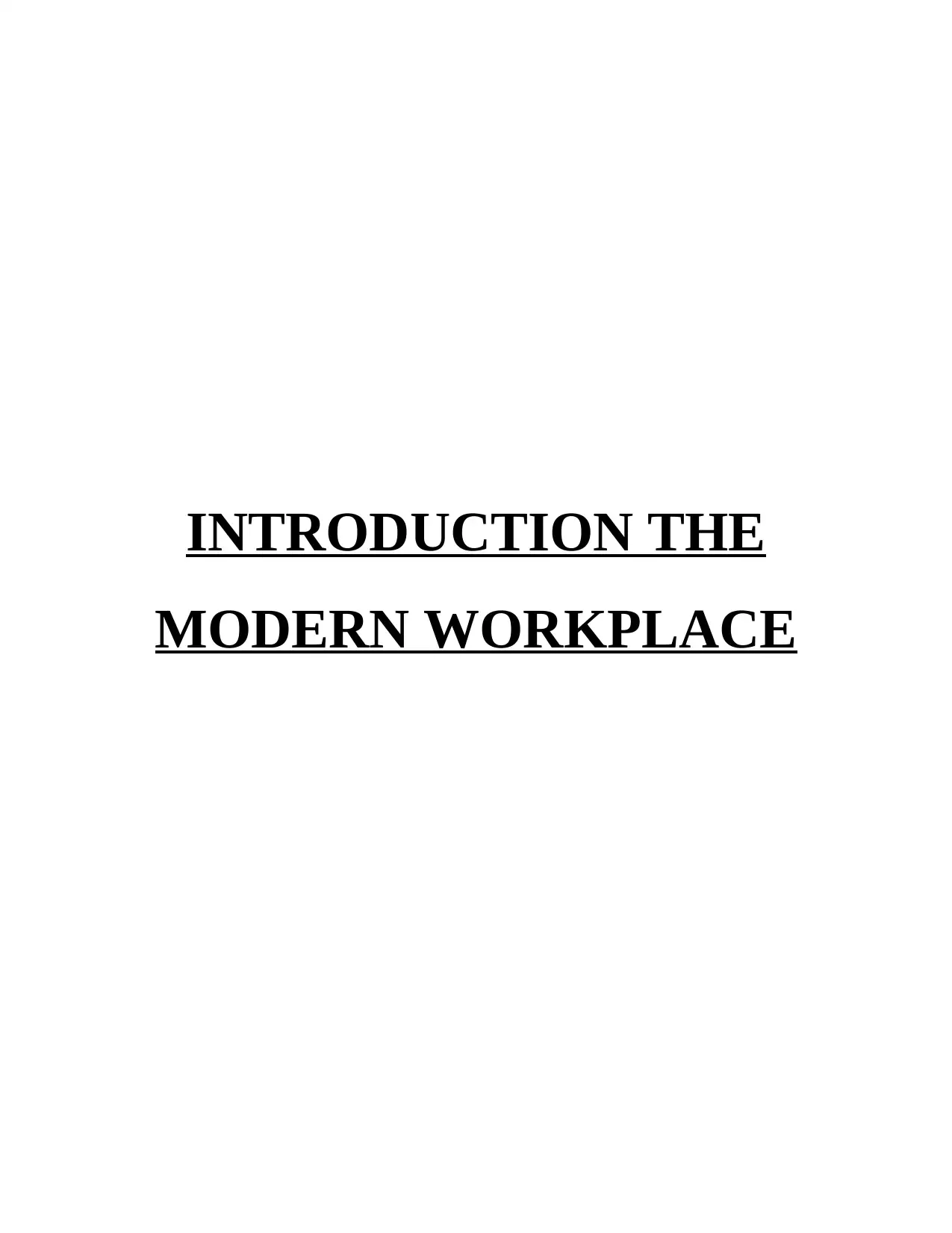
INTRODUCTION THE
MODERN WORKPLACE
MODERN WORKPLACE
Paraphrase This Document
Need a fresh take? Get an instant paraphrase of this document with our AI Paraphraser
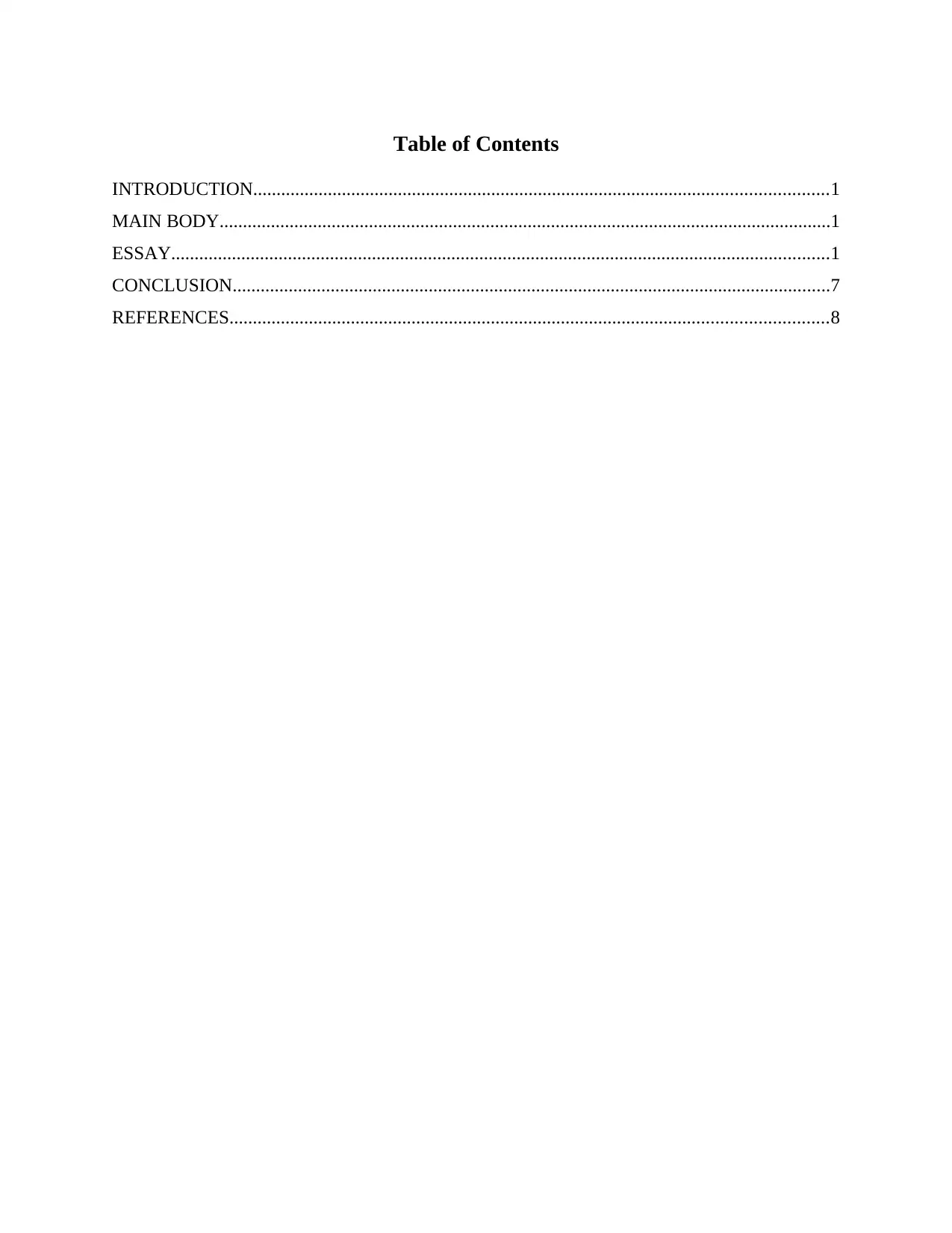
Table of Contents
INTRODUCTION...........................................................................................................................1
MAIN BODY...................................................................................................................................1
ESSAY.............................................................................................................................................1
CONCLUSION................................................................................................................................7
REFERENCES................................................................................................................................8
INTRODUCTION...........................................................................................................................1
MAIN BODY...................................................................................................................................1
ESSAY.............................................................................................................................................1
CONCLUSION................................................................................................................................7
REFERENCES................................................................................................................................8
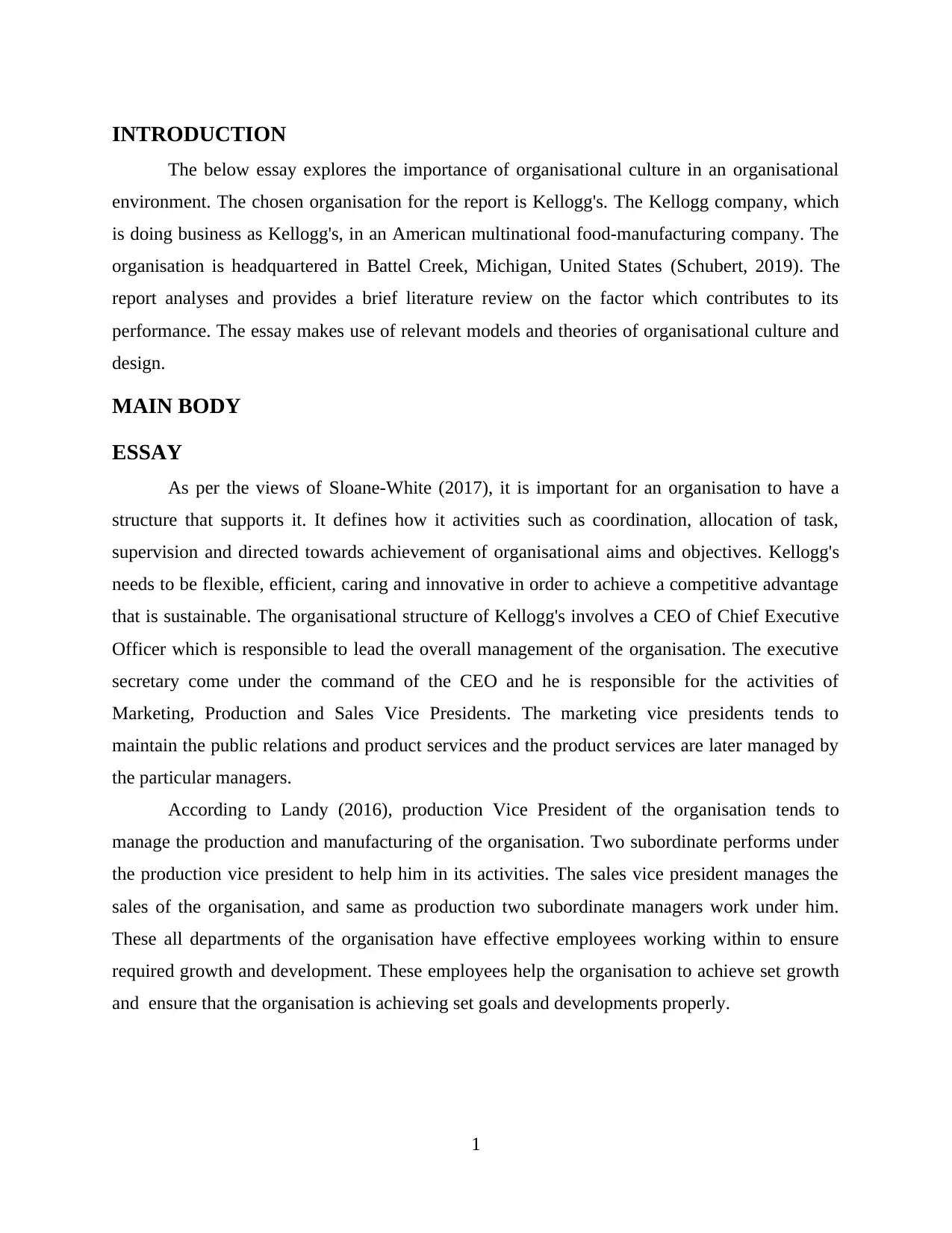
INTRODUCTION
The below essay explores the importance of organisational culture in an organisational
environment. The chosen organisation for the report is Kellogg's. The Kellogg company, which
is doing business as Kellogg's, in an American multinational food-manufacturing company. The
organisation is headquartered in Battel Creek, Michigan, United States (Schubert, 2019). The
report analyses and provides a brief literature review on the factor which contributes to its
performance. The essay makes use of relevant models and theories of organisational culture and
design.
MAIN BODY
ESSAY
As per the views of Sloane-White (2017), it is important for an organisation to have a
structure that supports it. It defines how it activities such as coordination, allocation of task,
supervision and directed towards achievement of organisational aims and objectives. Kellogg's
needs to be flexible, efficient, caring and innovative in order to achieve a competitive advantage
that is sustainable. The organisational structure of Kellogg's involves a CEO of Chief Executive
Officer which is responsible to lead the overall management of the organisation. The executive
secretary come under the command of the CEO and he is responsible for the activities of
Marketing, Production and Sales Vice Presidents. The marketing vice presidents tends to
maintain the public relations and product services and the product services are later managed by
the particular managers.
According to Landy (2016), production Vice President of the organisation tends to
manage the production and manufacturing of the organisation. Two subordinate performs under
the production vice president to help him in its activities. The sales vice president manages the
sales of the organisation, and same as production two subordinate managers work under him.
These all departments of the organisation have effective employees working within to ensure
required growth and development. These employees help the organisation to achieve set growth
and ensure that the organisation is achieving set goals and developments properly.
1
The below essay explores the importance of organisational culture in an organisational
environment. The chosen organisation for the report is Kellogg's. The Kellogg company, which
is doing business as Kellogg's, in an American multinational food-manufacturing company. The
organisation is headquartered in Battel Creek, Michigan, United States (Schubert, 2019). The
report analyses and provides a brief literature review on the factor which contributes to its
performance. The essay makes use of relevant models and theories of organisational culture and
design.
MAIN BODY
ESSAY
As per the views of Sloane-White (2017), it is important for an organisation to have a
structure that supports it. It defines how it activities such as coordination, allocation of task,
supervision and directed towards achievement of organisational aims and objectives. Kellogg's
needs to be flexible, efficient, caring and innovative in order to achieve a competitive advantage
that is sustainable. The organisational structure of Kellogg's involves a CEO of Chief Executive
Officer which is responsible to lead the overall management of the organisation. The executive
secretary come under the command of the CEO and he is responsible for the activities of
Marketing, Production and Sales Vice Presidents. The marketing vice presidents tends to
maintain the public relations and product services and the product services are later managed by
the particular managers.
According to Landy (2016), production Vice President of the organisation tends to
manage the production and manufacturing of the organisation. Two subordinate performs under
the production vice president to help him in its activities. The sales vice president manages the
sales of the organisation, and same as production two subordinate managers work under him.
These all departments of the organisation have effective employees working within to ensure
required growth and development. These employees help the organisation to achieve set growth
and ensure that the organisation is achieving set goals and developments properly.
1
⊘ This is a preview!⊘
Do you want full access?
Subscribe today to unlock all pages.

Trusted by 1+ million students worldwide

(Source: Business organisation chart, 2018)
Conte (2016), states that the culture of Kellogg's is Clan Culture, the working
environment in this culture is a friendly one. People which are working in the organisation have
a lot in common it is also similar to a large family. The executives or leaders of the organisation
are seen as mentors and as father figures as well. Kellogg's in this culture is held together by
tradition and loyalty along with its there is a great involvement.
Similarly, Byström (2017) states that the success of the organisation is defined with the
framework of addressing the client needs and caring for the people and Kellogg's tends to
2
Illustration 1: Organisational Structure of Kellogg's
Conte (2016), states that the culture of Kellogg's is Clan Culture, the working
environment in this culture is a friendly one. People which are working in the organisation have
a lot in common it is also similar to a large family. The executives or leaders of the organisation
are seen as mentors and as father figures as well. Kellogg's in this culture is held together by
tradition and loyalty along with its there is a great involvement.
Similarly, Byström (2017) states that the success of the organisation is defined with the
framework of addressing the client needs and caring for the people and Kellogg's tends to
2
Illustration 1: Organisational Structure of Kellogg's
Paraphrase This Document
Need a fresh take? Get an instant paraphrase of this document with our AI Paraphraser
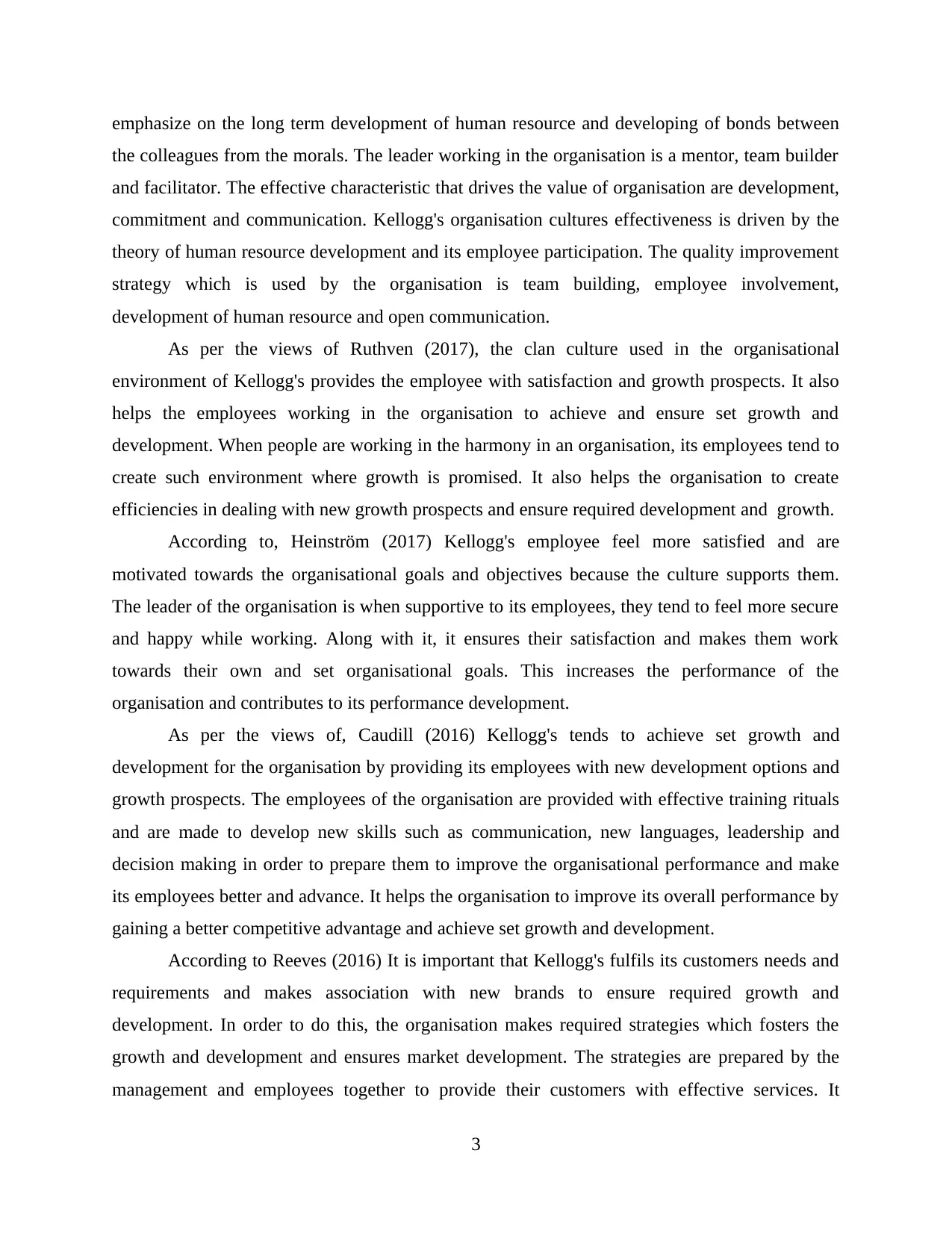
emphasize on the long term development of human resource and developing of bonds between
the colleagues from the morals. The leader working in the organisation is a mentor, team builder
and facilitator. The effective characteristic that drives the value of organisation are development,
commitment and communication. Kellogg's organisation cultures effectiveness is driven by the
theory of human resource development and its employee participation. The quality improvement
strategy which is used by the organisation is team building, employee involvement,
development of human resource and open communication.
As per the views of Ruthven (2017), the clan culture used in the organisational
environment of Kellogg's provides the employee with satisfaction and growth prospects. It also
helps the employees working in the organisation to achieve and ensure set growth and
development. When people are working in the harmony in an organisation, its employees tend to
create such environment where growth is promised. It also helps the organisation to create
efficiencies in dealing with new growth prospects and ensure required development and growth.
According to, Heinström (2017) Kellogg's employee feel more satisfied and are
motivated towards the organisational goals and objectives because the culture supports them.
The leader of the organisation is when supportive to its employees, they tend to feel more secure
and happy while working. Along with it, it ensures their satisfaction and makes them work
towards their own and set organisational goals. This increases the performance of the
organisation and contributes to its performance development.
As per the views of, Caudill (2016) Kellogg's tends to achieve set growth and
development for the organisation by providing its employees with new development options and
growth prospects. The employees of the organisation are provided with effective training rituals
and are made to develop new skills such as communication, new languages, leadership and
decision making in order to prepare them to improve the organisational performance and make
its employees better and advance. It helps the organisation to improve its overall performance by
gaining a better competitive advantage and achieve set growth and development.
According to Reeves (2016) It is important that Kellogg's fulfils its customers needs and
requirements and makes association with new brands to ensure required growth and
development. In order to do this, the organisation makes required strategies which fosters the
growth and development and ensures market development. The strategies are prepared by the
management and employees together to provide their customers with effective services. It
3
the colleagues from the morals. The leader working in the organisation is a mentor, team builder
and facilitator. The effective characteristic that drives the value of organisation are development,
commitment and communication. Kellogg's organisation cultures effectiveness is driven by the
theory of human resource development and its employee participation. The quality improvement
strategy which is used by the organisation is team building, employee involvement,
development of human resource and open communication.
As per the views of Ruthven (2017), the clan culture used in the organisational
environment of Kellogg's provides the employee with satisfaction and growth prospects. It also
helps the employees working in the organisation to achieve and ensure set growth and
development. When people are working in the harmony in an organisation, its employees tend to
create such environment where growth is promised. It also helps the organisation to create
efficiencies in dealing with new growth prospects and ensure required development and growth.
According to, Heinström (2017) Kellogg's employee feel more satisfied and are
motivated towards the organisational goals and objectives because the culture supports them.
The leader of the organisation is when supportive to its employees, they tend to feel more secure
and happy while working. Along with it, it ensures their satisfaction and makes them work
towards their own and set organisational goals. This increases the performance of the
organisation and contributes to its performance development.
As per the views of, Caudill (2016) Kellogg's tends to achieve set growth and
development for the organisation by providing its employees with new development options and
growth prospects. The employees of the organisation are provided with effective training rituals
and are made to develop new skills such as communication, new languages, leadership and
decision making in order to prepare them to improve the organisational performance and make
its employees better and advance. It helps the organisation to improve its overall performance by
gaining a better competitive advantage and achieve set growth and development.
According to Reeves (2016) It is important that Kellogg's fulfils its customers needs and
requirements and makes association with new brands to ensure required growth and
development. In order to do this, the organisation makes required strategies which fosters the
growth and development and ensures market development. The strategies are prepared by the
management and employees together to provide their customers with effective services. It
3
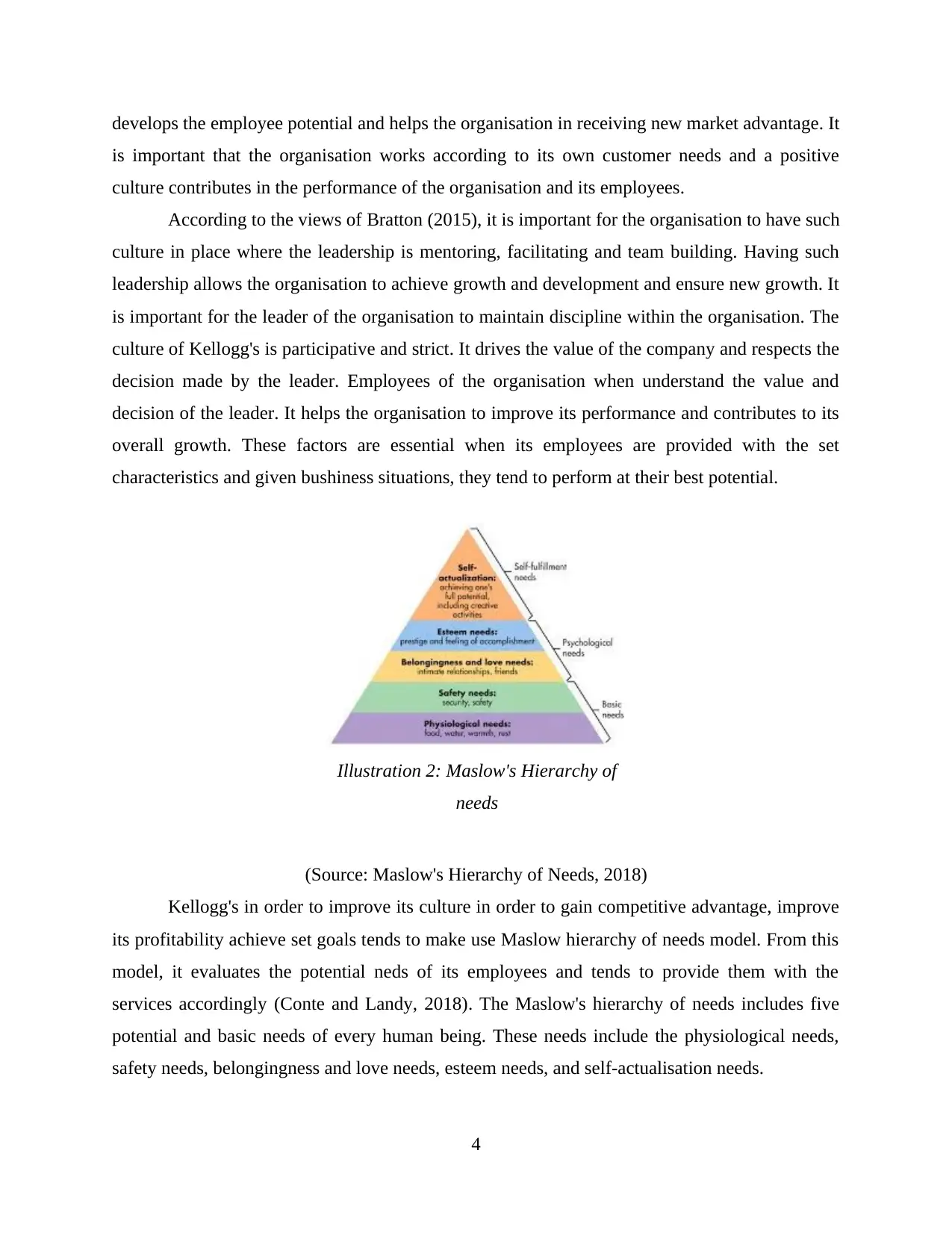
develops the employee potential and helps the organisation in receiving new market advantage. It
is important that the organisation works according to its own customer needs and a positive
culture contributes in the performance of the organisation and its employees.
According to the views of Bratton (2015), it is important for the organisation to have such
culture in place where the leadership is mentoring, facilitating and team building. Having such
leadership allows the organisation to achieve growth and development and ensure new growth. It
is important for the leader of the organisation to maintain discipline within the organisation. The
culture of Kellogg's is participative and strict. It drives the value of the company and respects the
decision made by the leader. Employees of the organisation when understand the value and
decision of the leader. It helps the organisation to improve its performance and contributes to its
overall growth. These factors are essential when its employees are provided with the set
characteristics and given bushiness situations, they tend to perform at their best potential.
(Source: Maslow's Hierarchy of Needs, 2018)
Kellogg's in order to improve its culture in order to gain competitive advantage, improve
its profitability achieve set goals tends to make use Maslow hierarchy of needs model. From this
model, it evaluates the potential neds of its employees and tends to provide them with the
services accordingly (Conte and Landy, 2018). The Maslow's hierarchy of needs includes five
potential and basic needs of every human being. These needs include the physiological needs,
safety needs, belongingness and love needs, esteem needs, and self-actualisation needs.
4
Illustration 2: Maslow's Hierarchy of
needs
is important that the organisation works according to its own customer needs and a positive
culture contributes in the performance of the organisation and its employees.
According to the views of Bratton (2015), it is important for the organisation to have such
culture in place where the leadership is mentoring, facilitating and team building. Having such
leadership allows the organisation to achieve growth and development and ensure new growth. It
is important for the leader of the organisation to maintain discipline within the organisation. The
culture of Kellogg's is participative and strict. It drives the value of the company and respects the
decision made by the leader. Employees of the organisation when understand the value and
decision of the leader. It helps the organisation to improve its performance and contributes to its
overall growth. These factors are essential when its employees are provided with the set
characteristics and given bushiness situations, they tend to perform at their best potential.
(Source: Maslow's Hierarchy of Needs, 2018)
Kellogg's in order to improve its culture in order to gain competitive advantage, improve
its profitability achieve set goals tends to make use Maslow hierarchy of needs model. From this
model, it evaluates the potential neds of its employees and tends to provide them with the
services accordingly (Conte and Landy, 2018). The Maslow's hierarchy of needs includes five
potential and basic needs of every human being. These needs include the physiological needs,
safety needs, belongingness and love needs, esteem needs, and self-actualisation needs.
4
Illustration 2: Maslow's Hierarchy of
needs
⊘ This is a preview!⊘
Do you want full access?
Subscribe today to unlock all pages.

Trusted by 1+ million students worldwide

Kellogg's by fulfilling these needs of its employees improves the organisational culture
and overall performance of its employees. It is important for the organisation to achieve set
growth and development and to ensure that its employees needs are being fulfilled. Employees
when provided with their needs and requirement tends to perform at their full potential and
brings growth to the organisation. At first, Kellogg's identifies the physiological needs of its
employees which includes food, warmth, water and rest. In order to provide its employees with
motivation to work for the organisation in order to achieve set growth and standards. The
organisation provides the effective food for their employees in its cafeteria. It provides the
employee with satisfaction and helps them to maintain a good health. Employees of the
organisation work with the full potential when they are provided with good food (Schubert,
2019). It helps the organisation to reach its set goals and make its employees achieve their own
and set organisational objectives.
The second identified need in the Maslow's hierarchy of needs is the safety needs of the
employees. The employees when provided with essential safety needs tend to perform better.
The organisation takes care of their belongings while its employees are working in their
operations. This helps the organisation to provide the employees with satisfaction that their
belongings are safe and secure. Along with it, the employees of the organisation are provided
with necessary provisions such as provident fund, and insurances which ensures that the future of
the employees is safe and secure. It helps the organisation to achieve new growth and because
from these provisions its employees feel safe and they do not worry about their future. It takes
away the need of safety from the minds of it employees and allow the organisation to grow and
develop itself in order to achieve growth and development.
This helps the organisation to achieve new growth prospects and help its employees in
developing and working as per their full potential. It makes the employees reach new level of
performance and allows the organisation to ensure that it is maintaining its own development and
competitive advantage from the help of its employees.
The third identified need in the Maslow Hierarchy of need is the need of belongingness
and love. The employees of the organisation tend to expect good relationships and friends when
they are working for the organisation (Sloane-White, 2017). In order to ensure this, the
organisation provides its employees with skill development opportunities such as gaining more
knowledge and developing themselves in a way that they are fulfilling their needs of love and
5
and overall performance of its employees. It is important for the organisation to achieve set
growth and development and to ensure that its employees needs are being fulfilled. Employees
when provided with their needs and requirement tends to perform at their full potential and
brings growth to the organisation. At first, Kellogg's identifies the physiological needs of its
employees which includes food, warmth, water and rest. In order to provide its employees with
motivation to work for the organisation in order to achieve set growth and standards. The
organisation provides the effective food for their employees in its cafeteria. It provides the
employee with satisfaction and helps them to maintain a good health. Employees of the
organisation work with the full potential when they are provided with good food (Schubert,
2019). It helps the organisation to reach its set goals and make its employees achieve their own
and set organisational objectives.
The second identified need in the Maslow's hierarchy of needs is the safety needs of the
employees. The employees when provided with essential safety needs tend to perform better.
The organisation takes care of their belongings while its employees are working in their
operations. This helps the organisation to provide the employees with satisfaction that their
belongings are safe and secure. Along with it, the employees of the organisation are provided
with necessary provisions such as provident fund, and insurances which ensures that the future of
the employees is safe and secure. It helps the organisation to achieve new growth and because
from these provisions its employees feel safe and they do not worry about their future. It takes
away the need of safety from the minds of it employees and allow the organisation to grow and
develop itself in order to achieve growth and development.
This helps the organisation to achieve new growth prospects and help its employees in
developing and working as per their full potential. It makes the employees reach new level of
performance and allows the organisation to ensure that it is maintaining its own development and
competitive advantage from the help of its employees.
The third identified need in the Maslow Hierarchy of need is the need of belongingness
and love. The employees of the organisation tend to expect good relationships and friends when
they are working for the organisation (Sloane-White, 2017). In order to ensure this, the
organisation provides its employees with skill development opportunities such as gaining more
knowledge and developing themselves in a way that they are fulfilling their needs of love and
5
Paraphrase This Document
Need a fresh take? Get an instant paraphrase of this document with our AI Paraphraser

belongingness. The organisation connects its employees with its colleagues by making use of
effective development opportunities. It provides its employees with opportunities such as
relationship building in which its employees are taught with how they can build effective
relationship with their colleagues and family members as well. Along with it, it helps the
organisation to reach new standards of growth when its employees love and belongingness needs
are fulfilled and they are working passionately for the organisation. It helps the employees to
build their morale and achieve set growth and development.
The fourth identified need is the need for esteem, in which its employees seek prestige
and accomplishment. In order to ensure this, the organisation provides its employees with new
growth and development opportunities (Landy and Conte, 2016). In which its tends to make
them work hard and receive good appreciation in the form of better salaries, incentives etc. It
helps the employees to work hard in order to receive these accomplishments and ensure growth
and development of their own and the organisation. It helps the organisation to make its
employees work hard and develop itself accordingly. Along with it, it helps the employees to
receive new set growth and development where they build a strong trust and loyalty for the
organisation and ensure its good reputation.
The fifth and the final identified need of the Maslow is the need of self-actualisation.
The needs of self-actualisation in Kellogg's tend to make its employees reach to the full potential.
For example, it is important for an employee working in the organisation to reach and understand
his full potential to achieve its set growth and development and to determine his efficiency. In
order to ensure this, the organisation tends to provide the employees working within its culture
with new development and growth prospects. In which it promotes them, allows them to develop
themselves by new management programmes and achieve new development options to achieve
new growth and development (Byström, Ruthven and Heinström, 2017). Along with it, it ensures
that its employees are loyal to the organisation. It helps the organisation to reach and fulfil its
own standards along with ensuring its employee growth and development.
The above mentioned Maslow needs of hierarchy is used by the organisation to develop
its employees and maintain a strong and positive organisational culture. They also drive the
organisational performance to reach on the top and adding a strong value to achieve desired
goals and objectives (Caudill and Reeves, 2016). It explains in what ways the organisation
achieve growth and its employees are motivated to reach full potential.
6
effective development opportunities. It provides its employees with opportunities such as
relationship building in which its employees are taught with how they can build effective
relationship with their colleagues and family members as well. Along with it, it helps the
organisation to reach new standards of growth when its employees love and belongingness needs
are fulfilled and they are working passionately for the organisation. It helps the employees to
build their morale and achieve set growth and development.
The fourth identified need is the need for esteem, in which its employees seek prestige
and accomplishment. In order to ensure this, the organisation provides its employees with new
growth and development opportunities (Landy and Conte, 2016). In which its tends to make
them work hard and receive good appreciation in the form of better salaries, incentives etc. It
helps the employees to work hard in order to receive these accomplishments and ensure growth
and development of their own and the organisation. It helps the organisation to make its
employees work hard and develop itself accordingly. Along with it, it helps the employees to
receive new set growth and development where they build a strong trust and loyalty for the
organisation and ensure its good reputation.
The fifth and the final identified need of the Maslow is the need of self-actualisation.
The needs of self-actualisation in Kellogg's tend to make its employees reach to the full potential.
For example, it is important for an employee working in the organisation to reach and understand
his full potential to achieve its set growth and development and to determine his efficiency. In
order to ensure this, the organisation tends to provide the employees working within its culture
with new development and growth prospects. In which it promotes them, allows them to develop
themselves by new management programmes and achieve new development options to achieve
new growth and development (Byström, Ruthven and Heinström, 2017). Along with it, it ensures
that its employees are loyal to the organisation. It helps the organisation to reach and fulfil its
own standards along with ensuring its employee growth and development.
The above mentioned Maslow needs of hierarchy is used by the organisation to develop
its employees and maintain a strong and positive organisational culture. They also drive the
organisational performance to reach on the top and adding a strong value to achieve desired
goals and objectives (Caudill and Reeves, 2016). It explains in what ways the organisation
achieve growth and its employees are motivated to reach full potential.
6
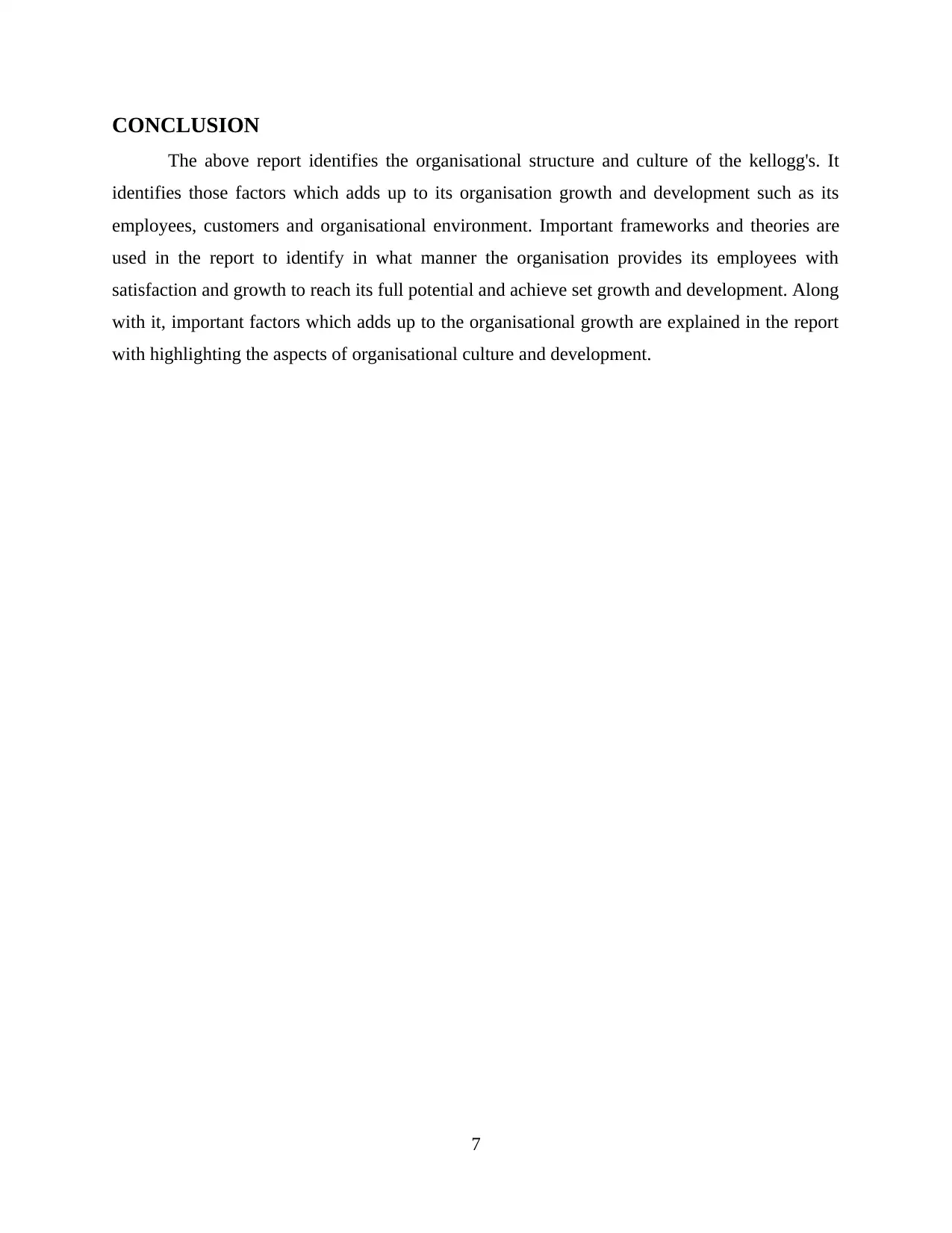
CONCLUSION
The above report identifies the organisational structure and culture of the kellogg's. It
identifies those factors which adds up to its organisation growth and development such as its
employees, customers and organisational environment. Important frameworks and theories are
used in the report to identify in what manner the organisation provides its employees with
satisfaction and growth to reach its full potential and achieve set growth and development. Along
with it, important factors which adds up to the organisational growth are explained in the report
with highlighting the aspects of organisational culture and development.
7
The above report identifies the organisational structure and culture of the kellogg's. It
identifies those factors which adds up to its organisation growth and development such as its
employees, customers and organisational environment. Important frameworks and theories are
used in the report to identify in what manner the organisation provides its employees with
satisfaction and growth to reach its full potential and achieve set growth and development. Along
with it, important factors which adds up to the organisational growth are explained in the report
with highlighting the aspects of organisational culture and development.
7
⊘ This is a preview!⊘
Do you want full access?
Subscribe today to unlock all pages.

Trusted by 1+ million students worldwide
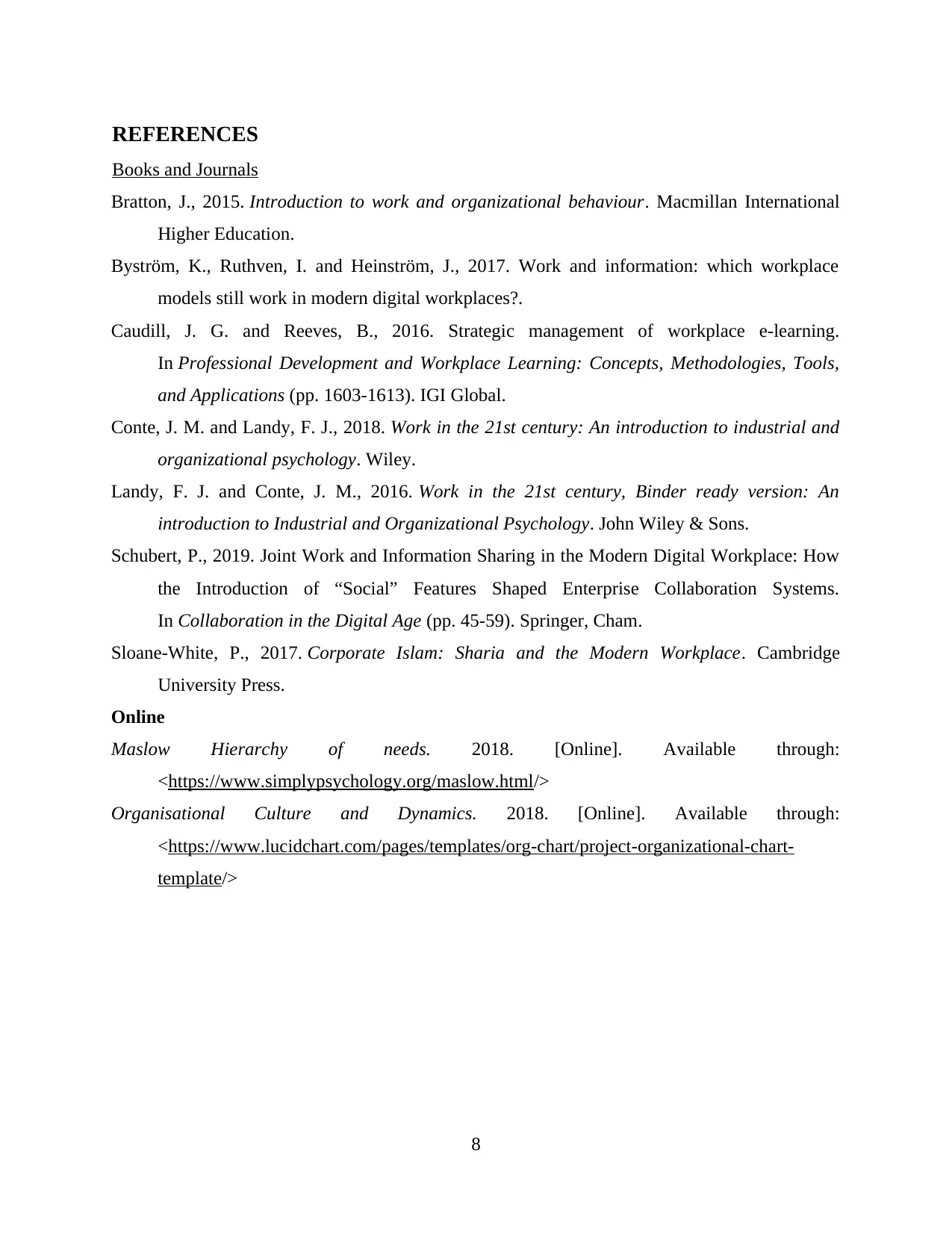
REFERENCES
Books and Journals
Bratton, J., 2015. Introduction to work and organizational behaviour. Macmillan International
Higher Education.
Byström, K., Ruthven, I. and Heinström, J., 2017. Work and information: which workplace
models still work in modern digital workplaces?.
Caudill, J. G. and Reeves, B., 2016. Strategic management of workplace e-learning.
In Professional Development and Workplace Learning: Concepts, Methodologies, Tools,
and Applications (pp. 1603-1613). IGI Global.
Conte, J. M. and Landy, F. J., 2018. Work in the 21st century: An introduction to industrial and
organizational psychology. Wiley.
Landy, F. J. and Conte, J. M., 2016. Work in the 21st century, Binder ready version: An
introduction to Industrial and Organizational Psychology. John Wiley & Sons.
Schubert, P., 2019. Joint Work and Information Sharing in the Modern Digital Workplace: How
the Introduction of “Social” Features Shaped Enterprise Collaboration Systems.
In Collaboration in the Digital Age (pp. 45-59). Springer, Cham.
Sloane-White, P., 2017. Corporate Islam: Sharia and the Modern Workplace. Cambridge
University Press.
Online
Maslow Hierarchy of needs. 2018. [Online]. Available through:
<https://www.simplypsychology.org/maslow.html/>
Organisational Culture and Dynamics. 2018. [Online]. Available through:
<https://www.lucidchart.com/pages/templates/org-chart/project-organizational-chart-
template/>
8
Books and Journals
Bratton, J., 2015. Introduction to work and organizational behaviour. Macmillan International
Higher Education.
Byström, K., Ruthven, I. and Heinström, J., 2017. Work and information: which workplace
models still work in modern digital workplaces?.
Caudill, J. G. and Reeves, B., 2016. Strategic management of workplace e-learning.
In Professional Development and Workplace Learning: Concepts, Methodologies, Tools,
and Applications (pp. 1603-1613). IGI Global.
Conte, J. M. and Landy, F. J., 2018. Work in the 21st century: An introduction to industrial and
organizational psychology. Wiley.
Landy, F. J. and Conte, J. M., 2016. Work in the 21st century, Binder ready version: An
introduction to Industrial and Organizational Psychology. John Wiley & Sons.
Schubert, P., 2019. Joint Work and Information Sharing in the Modern Digital Workplace: How
the Introduction of “Social” Features Shaped Enterprise Collaboration Systems.
In Collaboration in the Digital Age (pp. 45-59). Springer, Cham.
Sloane-White, P., 2017. Corporate Islam: Sharia and the Modern Workplace. Cambridge
University Press.
Online
Maslow Hierarchy of needs. 2018. [Online]. Available through:
<https://www.simplypsychology.org/maslow.html/>
Organisational Culture and Dynamics. 2018. [Online]. Available through:
<https://www.lucidchart.com/pages/templates/org-chart/project-organizational-chart-
template/>
8
1 out of 10
Related Documents
Your All-in-One AI-Powered Toolkit for Academic Success.
+13062052269
info@desklib.com
Available 24*7 on WhatsApp / Email
![[object Object]](/_next/static/media/star-bottom.7253800d.svg)
Unlock your academic potential
Copyright © 2020–2025 A2Z Services. All Rights Reserved. Developed and managed by ZUCOL.





